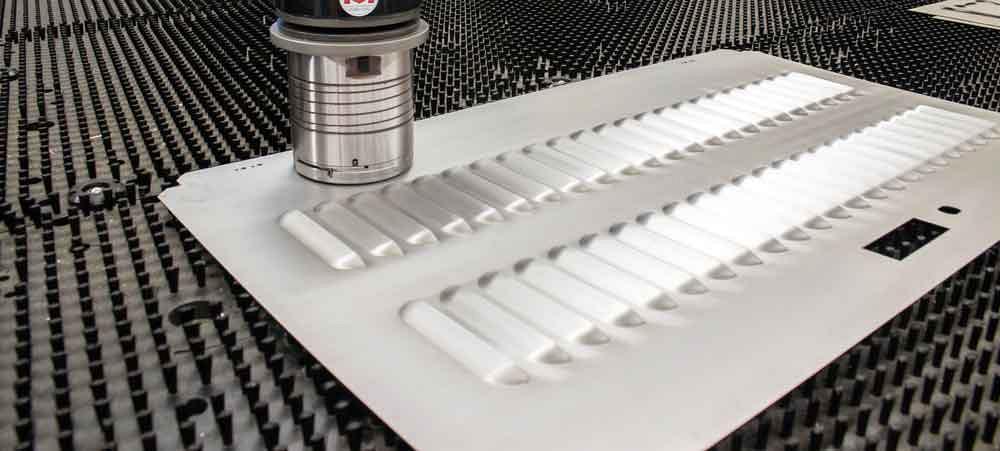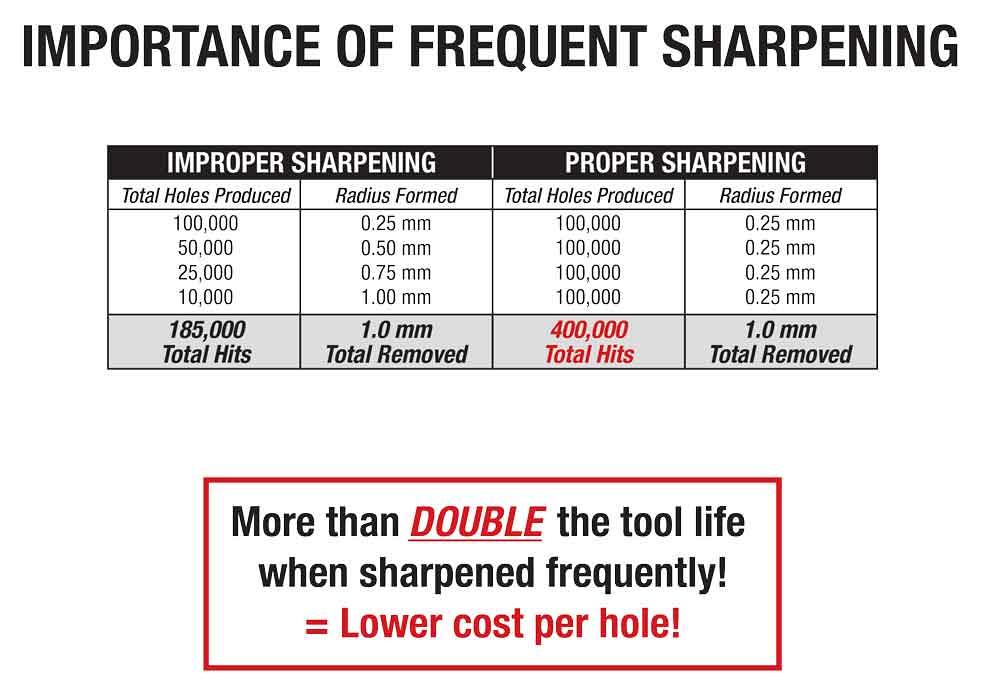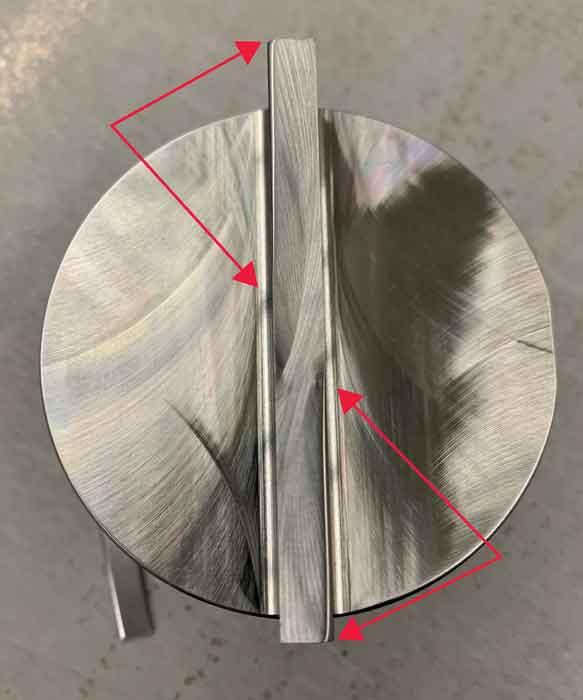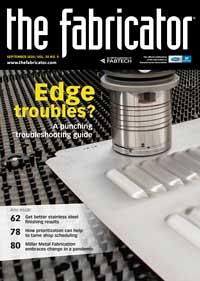Applications Technician
- FMA
- The Fabricator
- FABTECH
- Canadian Metalworking
Categories
- Additive Manufacturing
- Aluminum Welding
- Arc Welding
- Assembly and Joining
- Automation and Robotics
- Bending and Forming
- Consumables
- Cutting and Weld Prep
- Electric Vehicles
- En Español
- Finishing
- Hydroforming
- Laser Cutting
- Laser Welding
- Machining
- Manufacturing Software
- Materials Handling
- Metals/Materials
- Oxyfuel Cutting
- Plasma Cutting
- Power Tools
- Punching and Other Holemaking
- Roll Forming
- Safety
- Sawing
- Shearing
- Shop Management
- Testing and Measuring
- Tube and Pipe Fabrication
- Tube and Pipe Production
- Waterjet Cutting
Industry Directory
Webcasts
Podcasts
FAB 40
Advertise
Subscribe
Account Login
Search
Troubleshooting the punched sheet metal edge when metal punching
How to avoid a troubled edge and what to consider when operating a CNC punch press
- By John Ripka
- Updated August 10, 2023
- October 9, 2020
- Article
- Punching and Other Holemaking

Poor edge quality on a punched part can have many causes, all of which should be considered before jumping to conclusions. Image provided by Mate Precision Technologies
Worldwide, CNC punch press operators produce millions, if not billions, of parts monthly. The process appears straightforward, but the subtleties abound. Sometimes part quality is affected by its finished edge.
How do you avoid producing parts with inferior punched edges? As with so many problems in metal fabrication, various factors come into play. The trick is to consider them all before jumping to a conclusion, taking corrective action, and discovering that your edge problem stubbornly persists.
Tool Sharpening in Metal Punching
Worn or dull tooling can produce punched edges with more burrs. Increased burring can affect the way parts assemble and can be a safety hazard when handling parts. Dull tools also force machines to work harder to produce the same holes or features, accelerating machine wear and maintenance.When a visibly larger rollover appears on a part’s punch edge, it’s probably time to sharpen the tools. Sharpening tools regularly will help produce good-quality parts and help extend tool life. Tools should be sharpened when cutting edges are worn to a maximum radius of 0.010 in. (0.25 mm).
To inspect for this radius, hold the edge near a light source and look for reflections as the light bounces off the radiused edge. Also try the fingernail test: Lightly (and carefully) drag your fingernail across the edge; if that’s enough to lightly shave your fingernail, the punched edge is sharp and the tool has some life left. If you don’t see shavings, it might be time to sharpen your tool.
When sharpening tools, it’s best to remove a small amount of the tool surface more frequently rather than large amounts less frequently. Light, frequent sharpening helps extend tool life and improve part quality (see Figures 1 and 2).
After sharpening a tool on a tool grinding machine, use a sharpening stone to remove the small burr that develops on the punch point. Doing this will create a minimal radius, between 0.001 and 0.002 in., on the tool’s cutting edges.
The tools become magnetized when sharpened, so be sure to demagnetize them afterward. Forget this step and you might find punched slugs sticking to punch points and possibly ending up on top of the sheet, where the machine can press them into the sheet and create unwanted marks or dents. Slugs on top of the sheet and close to the punch point might result in a double material thickness being punched, which can damage the sheet and cause premature tool wear.
Metal Punching and Tool Dulling
What if you sharpen tools regularly, yet they still don’t stay sharp for long? In this case, look at the toolstation alignment. Improperly aligned toolstations cause premature tool and machine wear, poor part quality, not to mention inaccurate holes and features.Uneven tool wear or excessive burrs along the punched edge might indicate that the station needs vertical alignment (see Figures 3 and 4). Vertically aligning tooling stations ensures that the punch pushes the material through the die opening with the same amount of clearance on all sides of the punch point.
Also check for radial alignment, which keeps edges and contours straight and uniform. Radial alignment refers to the rotation or angular setting of a station. A misaligned station angle can create stepped or uneven punched edges, as well as incorrect angles for shaped punches.
A slitting or parting tool (typically a long rectangle) in a station that’s out of radial alignment can produce jagged edges in the punched part, an effect known as sawtoothing, creating a small step at the end of every punch location along the edge. It’s a good indicator that you need to realign the station radially. The longer the parting tool, the more pronounced the step is (see Figure 5).

Figure 1
When edges have a radius greater than 0.25 mm, it’s time to sharpen both your punches and dies. (Click on figure for complete image.)
Every fabrication shop should have a good set of alignment tools for periodic punch station inspections and adjustments. Whether you’re using the standard two-pin variety or more elaborate LED tools, both are designed to align tools vertically and radially (see Figure 6). To set stations radially, you will typically need a magnetic-based dial indicator and a sturdy steel sheet, ideally 14 ga. or thicker, to traverse the indicator along a screw-on bar for the alignment tool to measure angularity.
Nibbling When Metal Punching
Nibbling can prematurely wear tool edges, which in turn can affect edge quality in holes and contours. A punch tool usually nibbles with one full-sized hit followed by a number of partial hits. Side-loading occurs when less than half of the punch point contacts the sheet surface, with the punch point deflecting toward the open area of the sheet and away from the contact point between the punch and material. Such deflection changes the clearance around the sides or circumference of the punch.With extreme deflection, or even just a little deflection when punching with very tight clearances, the punch point can actually contact the die edge on the open side of the material, damaging the worn cutting surface in that area. This can cause excessive or uneven burrs, as well as oblong or egg-shaped holes with round punches.
You can avoid nibbling by using specially shaped tools that match the contour being punched. Such tools will produce a better edge and reduce the number of hits required to punch a feature, which also reduces tool and machine wear.
If you can’t avoid nibbling, use fully guided tools, which can minimize punch deflection or eliminate it entirely. With multiple or extended guiding surfaces that control the punch-point position, fully guided tools can be ideal for nibbling applications and punching hole diameters smaller than the material thickness. That said, they might not be the best choice for punching soft materials such as aluminum or hard materials such as stainless steel—both of which are susceptible to galling, or a buildup of the punched material on the punch tip. Galling adds to the punch point’s overall diameter and decreases clearance between the punch and stripper (or the punch and die), which can lead to stripping issues, poor hole quality, and premature tool wear.
Treated and Coated Tools
Particularly useful when punching materials with a tendency for galling, tooling treatments and coating options abound. Tooling treatments are typically infused into the punch material to improve its properties, while coatings are thin layers or additions to tooling that add lubricity. Both can minimize or eliminate problems with galling.Lubricated punch pads, which provide lubrication on the punch tip, can also help reduce or eliminate galling. All of these products will increase tool life and improve tooling performance.
Tool Stripping
Stripping errors can lead to distorted or puckered holes when a punch point sticks in the sheet and doesn’t strip properly. If a punch is repeatedly sticking or the sheet is “popping” off the punch point, it might be time for some punch assembly maintenance.Stripping errors could be caused by worn, damaged, or broken springs in the punch assembly. Although these springs are durable, they may wear over time. If springs are fatigued, cracked, or broken, they should be replaced.
Keep interior punch components clean and well-lubricated. Dirty or dry tooling components—such as the punch body, guide body, guide interior, and turret bore (if applicable)—prevent the springs from performing to their ability and can lead to stripping issues.
If you have turret presses, make sure lifting pins and lifter springs are straight and undamaged (see Figure 7), and replace them if they’re worn or damaged. Worn or damaged turret keys should also be replaced and aligned when needed.
Because dull tools also can contribute to stripping problems, keep tools sharp and clean. If you are punching heavy or thick material and experiencing stripping problems, consider using heavy-duty tool configurations.
Proper Clearance for Metal Punching
To create a hole, a punch presses material into and through a die opening. As the material is forced through the die opening, it begins to crack and eventually fracture, producing a slug that is pushed through the die and into a slug collector or scrap bin.Proper clearance between the punch and die is essential. If the die clearance is too tight, the resulting hole may be good, but the force required to create that hole increases, and stripping becomes difficult. All this generates more heat, which fosters galling on the punch point. At the other extreme, excessive die clearance causes more rollover, or rounded top edges, in the punched part, and increased cracking and fracturing create rough edges and large burrs.
Tool Steel
One type of tool steel cannot punch every material equally well in every application. Should you select a tool with greater toughness or wear resistance? How do you plan to treat or coat your tools?
Figure 2
Proper sharpening can increase the total number of hits you can get out of a tool. (Click on figure for complete image.)
Consider a tool steel’s material composition and know that not all tool steels are created equally. M2 high-speed steel has poor toughness but good wear resistance. A2, an air-hardened tool steel, has good toughness and fair wear resistance. D2, a high-carbon chromium steel, has fair toughness and good wear resistance. S7, a shock-resisting tool steel, has exceptional toughness but poor wear resistance. PM-M4, a powdered-metal tool, has excellent abrasion resistance and fair toughness.
Don’t Overlook the Machine Design
Most punch presses are constructed with a C or O (portal) frame. Both can produce high-quality parts at exceptional speeds, though which performs best will depend on the punching applications you have.C-frame machines have the ram at the top and end of the frame, while O-frame systems have the ram centered within the frame. If processing thicker or heavier material, or if you have high-tonnage applications, you might consider a portal-frame machine. The O-style frame helps prevent deflection or distortion when punching. Higher-tonnage hits might deflect in a C-style machine, where more flexing of the frame is possible.
Metal Punching: The Big Picture
Poor edge quality can have many root causes. Poor tool sharpening and maintenance practices might be to blame, but you might find other culprits too. Your machine might be out of alignment. You might need special-shape tools or tools with treatments or coatings. The tool steels in your punches and dies might not suit the application. The machine’s design, including its frame type, also can factor into the equation.
If edge problems persist, try not to jump to a conclusion without first considering all the potential causes. Doing so will help you get back to doing what really matters: producing high-quality parts.
About the Author
John Ripka
1295 Lund Blvd.
Anoka, MN 55303
763-421-0230
Related Companies
subscribe now

The Fabricator is North America's leading magazine for the metal forming and fabricating industry. The magazine delivers the news, technical articles, and case histories that enable fabricators to do their jobs more efficiently. The Fabricator has served the industry since 1970.
start your free subscription- Stay connected from anywhere

Easily access valuable industry resources now with full access to the digital edition of The Fabricator.

Easily access valuable industry resources now with full access to the digital edition of The Welder.

Easily access valuable industry resources now with full access to the digital edition of The Tube and Pipe Journal.
- Podcasting
- Podcast:
- The Fabricator Podcast
- Published:
- 04/16/2024
- Running Time:
- 63:29
In this episode of The Fabricator Podcast, Caleb Chamberlain, co-founder and CEO of OSH Cut, discusses his company’s...
- Industry Events
16th Annual Safety Conference
- April 30 - May 1, 2024
- Elgin,
Pipe and Tube Conference
- May 21 - 22, 2024
- Omaha, NE
World-Class Roll Forming Workshop
- June 5 - 6, 2024
- Louisville, KY
Advanced Laser Application Workshop
- June 25 - 27, 2024
- Novi, MI
































